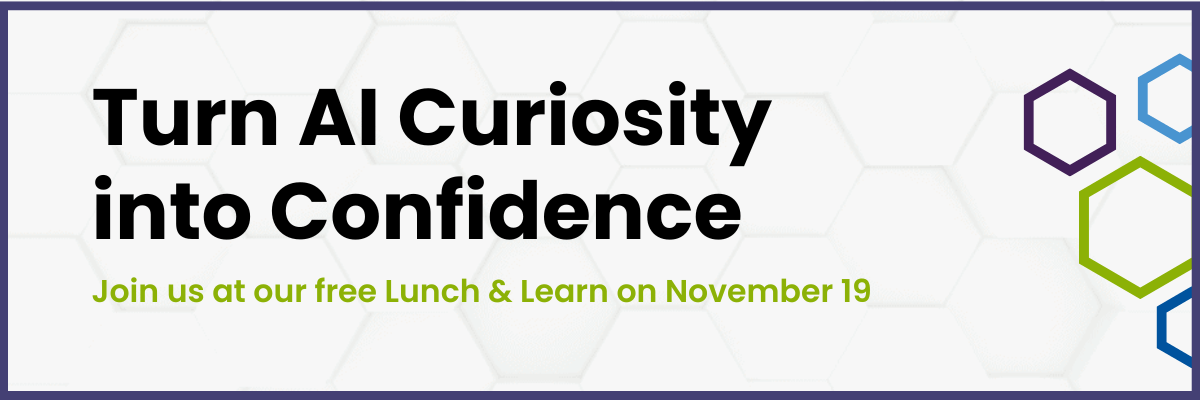More and more frequently we’re seeing artificial intelligence (AI) become part of everyday business and the way we work. Microsoft’s Copilot AI is now a firmly established aspect of the Microsoft 365 ecosystem, with them recently announcing their plan to start automatically installing the Microsoft 365 Copilot app on Windows devices from October 2025.
But before you rush to enable it, ask yourself if your business is ready. Successful Copilot adoption takes preparation. The businesses that see real AI return on investment (ROI) are the ones that take time to evaluate their data, security, and people first.
In this blog, we’ll explore five critical questions to help you determine if your organization is ready for Microsoft Copilot. You’ll learn how to approach AI governance, training, and change management strategically – and how to avoid the common AI deployment challenges that can derail success.
1. Is Your Microsoft 365 Data Ready for Copilot to Learn From?
Before you can get meaningful insights from Copilot, you need to make sure your data is in order. Copilot works by analyzing the information stored across Microsoft 365 – including emails, chats, documents, and spreadsheets – to deliver intelligent recommendations. If that data is disorganized, duplicated, or insecure, the results will be unreliable at best and risky at worst.
Strong AI governance is the foundation of every successful deployment. That means ensuring data is properly classified, access permissions are clearly defined, and compliance requirements are met. Without these controls, AI can surface outdated information, expose sensitive data, or make suggestions that simply don’t align with reality.
This is where a little preparation goes a long way. Start by auditing your Microsoft 365 environment:
- Are file permissions and sharing settings up to date?
- Is your data accurate, consistent, and easy to find?
- Do you have clear policies on who can access what?
Cleaning and structuring your data doesn’t just reduce risk; it also directly improves your potential ROI by giving Copilot the high-quality information it needs to deliver real value.
2. Can Your Security and Compliance Keep Pace with Copilot’s Access?
AI can be a powerful productivity booster, but it also changes your cybersecurity landscape. Microsoft Copilot draws on vast amounts of company data, which means it has access to sensitive business information by design. It also means that without strong safeguards, that same convenience can quickly become a liability.
One of the most common AI deployment challenges we see is a lack of proper identity and access management. If permissions aren’t clearly defined, Copilot might surface confidential data to users who shouldn’t see it. Similarly, compliance gaps around data residency or retention can put your business at risk if the right governance isn’t in place.
The key is to balance innovation with protection. Every successful Copilot rollout should include:
- Multi-factor authentication and conditional access policies.
- Regular reviews of user permissions and shared resources.
- Continuous monitoring for data exposure or unusual activity.
When these safeguards are built into your digital transformation strategy, your organization can adopt AI confidently, knowing security and compliance are never compromised.
3. Are Your Teams Ready to Collaborate Confidently with Copilot?
Even the best technology falls flat if people don’t understand or trust it. One of the biggest barriers to AI success isn’t the software itself; it’s user adoption – training ranks as the most important factor for generative AI adoption with 48% of employees, but almost half feel they’re not getting the support they need. Microsoft Copilot may feel intuitive, but unlocking its full potential requires confidence, training, and a shared sense of purpose across your team.
This is where effective AI change management comes in. It’s not enough to simply turn Copilot on; you need to guide your employees through how and why it’s being introduced. Clear communication, hands-on learning, and ongoing support can make the difference between enthusiastic adoption and quiet resistance.
When users understand how Copilot enhances their work rather than replaces it, adoption happens naturally. That’s when the real AI ROI starts to show – through productivity gains, smarter data-driven decision-making, and a workforce that’s confident using AI responsibly.
4. Do You Know Where Copilot Can Deliver the Most Value?
AI adoption isn’t a goal in itself. It’s a means to achieve specific business outcomes. Too often, organizations enable Microsoft Copilot because it’s the “next big thing,” without defining what success actually looks like. That’s a fast track to frustration and wasted investment.
Before deployment, take a step back and ask:
- What problems are we trying to solve?
- How will we measure success – time saved, errors reduced, productivity increased?
- Which departments or workflows will benefit most?
Tying your implementation to measurable objectives ensures your AI ROI is both visible and defensible. Maybe your finance team wants to automate report summaries, or your sales department needs quicker proposal generation; whatever the case, machine learning adoption should directly support your core business goals.
This approach also makes it easier to communicate the value of AI internally. When employees and leadership see real results, enthusiasm grows and adoption follows naturally. At Anderson Technologies, our team works with you to map Copilot use cases to tangible outcomes, ensuring every AI initiative is a strategic extension of your digital transformation strategy and not just another piece of software.
5. Is Your Leadership Team Ready to Champion AI-Driven Change?
AI adoption starts at the top. Even with the right tools, data, and training, Microsoft Copilot won’t transform your business unless leadership actively champions it. The most successful implementations are those where leaders model the behavior they want to see, which means using AI themselves, communicating its purpose clearly, and showing teams how it aligns with long-term business goals.
Strong leadership also helps navigate AI deployment challenges such as employee hesitation, process redesign, and cross-department alignment. When executives treat AI as part of the broader digital transformation strategy, it signals to employees that this is a meaningful, lasting change.
Setting a clear vision is crucial. Employees need to understand why Copilot is being introduced and how it supports better collaboration, efficiency, and innovation. Transparency builds trust, and trust drives adoption.
Copilot Curiosity Becomes Confidence at Our AI Lunch & Learn
Preparing for Microsoft Copilot isn’t just a case of installing a new feature. In order to achieve sustainable success, some groundwork must be laid first. From strong data foundations and security controls to training, strategy, and leadership, each of these readiness factors determines whether AI becomes a genuine competitive advantage or just another unrealized investment.
At Anderson Technologies, we believe AI ROI starts with readiness. By approaching AI governance, change management, and deployment thoughtfully, your business can achieve meaningful outcomes: stronger productivity, smarter data-driven decision-making, and a culture that embraces innovation safely.
If you’re ready to see how Copilot can work for your organization, join us at our AI Lunch & Learn event on November 19th. Enjoy lunch, connect with other local business leaders, and gain practical insights from our experts on preparing your Microsoft 365 environment for Copilot. Reserve your spot today and take the first step toward transforming your business with AI.



